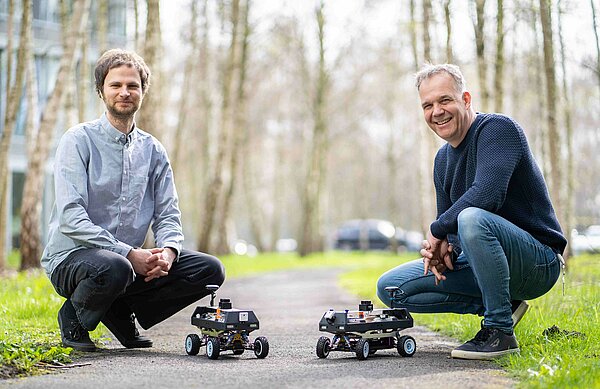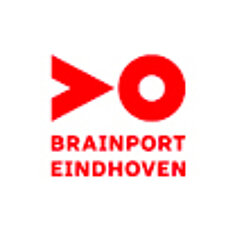From Data Continuity to Autonomous Driving: NXP’s Role in Future-Proofing Vehicles

"There is great potential to improve traffic flow and make driving safer and easier."
Interview with Brian de Bart and Matteo Ridolfi of NXP
Within the project Digital Infrastructure for Future-proof Mobility (DITM), Dutch companies, organizations, and knowledge institutions collaborate to future-proof the digital infrastructure in the field of mobility. Special attention is given to technologies related to localization, traffic services, digital maps, and charging infrastructure. The goal of the project is to achieve a higher level of autonomous driving and to ensure the safe, reliable, and efficient integration between electric vehicles and the energy infrastructure. The project is divided into five work packages, in which the involved parties collectively focus on specific aspects.
Improving through innovation
The Dutch company NXP Semiconductors, developer of chips and associated software, is one such party. Brian de Bart and Matteo Ridolfi are involved in work packages two and three of DITM on behalf of the organization. Both are part of NXP's Automotive System Innovation Team. Brian explains their work: "With the team, we build innovative systems, combining software and hardware to create a collaborative system. We test whether we can find new applications for existing chips or define specifications for new chips." As the name suggests, the team focuses on the automotive market, working on in-vehicle architectures, Advanced Driver Assistance Systems (ADAS), and vehicle electrification, among other things. Their aim is to enhance the safety, efficiency, and performance of vehicles through innovative technologies.
"Continuity in data transport is sometimes vital."

There is only one relevant message: braking
The subject of "In-Vehicle Architectures" concerns the electrical connections in the car. For example, there are (radar) sensors, cameras, a central computer, screens in the back for children watching Netflix, your car radio, and electric windows. Brian explains: "All these components need to exchange information with each other and are therefore interconnected by cables, resulting in a modern car carrying a significant wiring harness. Automakers want to optimize this; data speeds are increasing because sensors are becoming more precise, and cameras have higher resolutions. Automakers struggle with the fact that they want to reduce the weight of the car while simultaneously transmitting more data over the cables. Additionally, we look at prioritization; if the children in the back are watching Netflix, they are using a high data speed. A one-second glitch there doesn't cause major problems. If the radar detects a pedestrian in front of the car at the same time, an immediate response is required. There is only one relevant message then: braking. It is crucial that this message reaches the right place immediately. Continuity in data transport is vital here."
Anticipating
The team also deals with Advanced Driver Assistance Systems (ADAS), bringing together all vehicle safety functions to ultimately achieve a high level of automated driving. To achieve this, the car must be aware of its surroundings and anticipate what is happening. NXP primarily focuses on radar to detect objects but also explores other ways to provide the car with as much information as possible. One of these is positioning: if the vehicle knows exactly where it is, it can better respond to the situation.
So within DITM, we have a significant task. That's why we are involved in work packages two and three," Matteo explains.
"We've built small prototypes to simulate indoor situations."
UltraWideBand as a solution
Within DITM, Matteo focuses on work package two, which deals with vehicle localization. His focus is on UltraWideBand (UWB). "This technology provides more robust and stable communication than, for example, Wi-Fi. The beauty of ultra-wideband is that it measures distances very accurately. So we can use UWB systems to determine your position. GPS, for example, doesn't work in tunnels, so you don't know exactly where you are. We are working on the navigation of autonomously driving buses in a closed bus depot, which can ultimately travel or park autonomously. One of the characteristics of UWB is that it is a very robust technology for indoor scenarios such as a bus depot," Matteo explains. "We collaborate with TNO and VDL on this. We are researching ways to allow buses to drive autonomously into the depot, automatically go to the charging station at night, go through the car wash, and park. For this, we have built small prototypes with which we simulate these indoor situations."

Safety first
The team also works on vehicle electrification, including components such as onboard chargers or batteries. "Of course, everyone wants the shortest charging time and the longest range. So we try to optimize the algorithms. Fast charging means putting a lot of energy into the car in a few minutes. So it gets very hot, and if it gets too hot, it can cause a fire. The trick is to measure the temperature accurately and stay below a safe distance. More accurate measurement means you can use a smaller safety distance and therefore charge even faster. Work package three focuses on securing the energy system. Brian explains: "Our partner Heliox in work package three is building a large charging system for a bus company. This charger is intended for the depot, which is a shielded area. If this system is also used in public charging points, we need to prevent anyone from hacking it. The risk of deliberately overloading the power grid exists. Our focus within DITM is therefore on safety during charging. So we look at the entire safety chain, from the vehicle to the network of network operator TenneT. We do this together with other parties such as TNO."
A Brabant sausage roll
The connection with other partners within the project is important. "Within DITM, we work together with national and regional partners. The atmosphere is good, and we regularly eat a sausage roll together to brainstorm, how nice is that," Brian laughs. An example of this collaboration is radar localization. With radar, you can see a whole area of moving objects, from pedestrians to other cars. "We are now working with TNO, Sioux, and TomTom on how to use radar for localization. The familiar GPS is accurate to within five meters, so it doesn't know if you're in the left or right lane. TomTom's maps accurately depict the environment. Roads and buildings, but also trees and streetlights. We are investigating whether we can overlay radar data from the vehicle on these maps to determine the position of the vehicle relative to moving objects in the environment even more precisely. TNO is responsible for the tests and tries to optimize the results."
Improving together
These connections also exist on the UltraWideBand side. Matteo explains: "TNO tests the localization system we have devised in the use case of the bus depot. They provide feedback on its operation and tips for any adjustments. Because the bus depot is a closed environment and inaccessible to GPS, there are specific considerations to be taken into account. For example, the buses must park themselves thirty centimeters apart. The transmission system does not like the metal buses are made of. So your accuracy can decrease. We want to know if the accuracy decreases and by how much. With this data, we try to improve positioning together."
"We are at the beginning of making all relevant information available to drivers."
More convenience and improved accessibility
Will the residents of the Netherlands also notice something from these innovations? “The buses that VDL develops improve the passenger experience. Of course, travelers do not see that the bus drives independently through the depot at night, charges and parks itself. But they do notice. The bus will have many more functions, such as the precise location where it stops. This makes getting in and out much easier. We will see smaller buses that run more often. This increases accessibility and reduces the total travel time. What we are trying to do in DITM is connect the digital infrastructure. There is a huge amount of information and data available. We are at the beginning of opening up all that information to directors. There is a lot of potential to improve traffic flow and make driving safer and easier,” said Brian.
Valuable collaboration
NXP is looking for collaboration with other companies in order to take concrete steps. “We always try to look at the ecosystem of the companies around us to accelerate innovations and find out which companies are interesting for us. These are often potential customers, a software partner or a customer of a customer. For example, we are now setting up a project with DAF on circular batteries. We continue to look at new areas, suitable companies and ways of working together. Of course we should not forget knowledge institutions such as TU/e. They are also part of this ecosystem, and conduct valuable scientific research in the field of these topics,” Brian concludes his argument.
